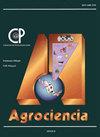BIOMASS PRODUCTION IN SPRING HABIT TRITICALE (X Triticosecale Wittmack) ELITE LINES
IF 0.5
4区 农林科学
Q4 AGRICULTURE, MULTIDISCIPLINARY
引用次数: 0
Abstract
In plant breeding, genotype behavior analysis under different development conditions and years of evaluation allows for the identification of desirable individuals. In this study, forage biomass production of 20 elite lines of spring habit triticale (X Triticosecale Wittmack) determined over a two-year evaluation period. The research was conducted in autumn-winter seasons of 2016-2017 and 2017-2018 in Celaya, Guanajuato, Mexico. It was carried out using a randomized complete block experimental design with three replications per year and combined analysis. The experimental unit included two furrows in an area of 8.0 m2. The variables measured were those related to green and dry forage yield, number of stems, number of leaves, and plant height in the milky-mass stage. Lines L-3, L-9, and L-4 showed higher averages of green and dry forage, more stems and leaves, increased plant height, and presented a late cycle; L-18, L-20, and L-19 yielded less, with a tendency to earlier and smaller plant size. The combined analysis revealed significant differences (p ≤ 0.05); the biplot showed that lines L-17, L-5, L-9, L-20, L-4, and L-19 had higher production in the first year of evaluation for green and dry forage, number of stems, as well as a higher number of leaves.春季小黑麦优良品系的生物量生产
在植物育种中,在不同发育条件下的基因型行为分析和多年的评估可以确定理想的个体。本研究测定了20个春习性小黑麦优良品系2年的牧草生物量产量。该研究于2016-2017年和2017-2018年秋冬季节在墨西哥瓜纳华托州塞拉亚进行。采用随机完全区组试验设计,每年3次重复,并进行联合分析。试验单元包括两个沟,面积为8.0 m2。测定的变量与乳浆期青草和干草料产量、茎数、叶数和株高有关。株系L-3、L-9和L-4平均青草量和干草料量较高,茎叶多,株高增高,株系周期较晚;L-18、L-20和L-19产量较低,且株型较早,株型较小。综合分析差异有统计学意义(p≤0.05);双标图显示,L-17、L-5、L-9、L-20、L-4和L-19品系在评价第一年的青干饲料产量、茎数和叶片数均较高。
本文章由计算机程序翻译,如有差异,请以英文原文为准。
求助全文
约1分钟内获得全文
求助全文
来源期刊

Agrociencia
农林科学-农业综合
CiteScore
0.50
自引率
33.30%
发文量
51
审稿时长
18-36 weeks
期刊介绍:
AGROCIENCIA is a scientific journal created and sponsored by the Colegio de Postgraduados. Its main objective is the publication and diffusion of agricultural, animal and forestry sciences research results from mexican and foreign scientists. All contributions are peer reviewed. Starting in the year 2000, AGROCIENCIA became a bimonthly and fully bilingual journal (Spanish and English versions in the same issue). Since 2007 appears every month and a half (eight issues per year). In addition to the printed issues, the full content is available in electronic format.
 求助内容:
求助内容: 应助结果提醒方式:
应助结果提醒方式:


